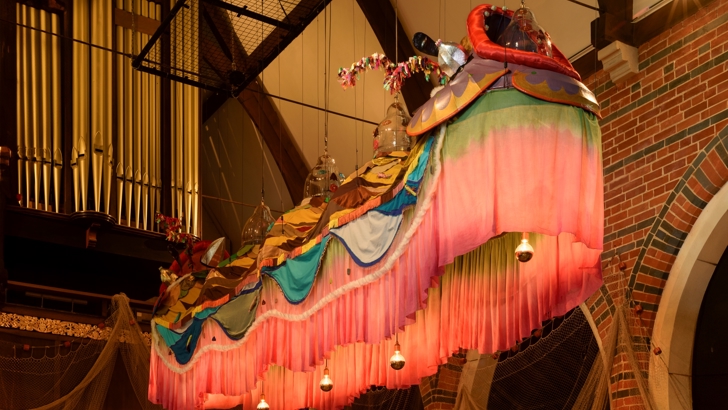Tramway presents Rae-Yen Song's most ambitious solo exhibition to date

Rae-Yen Song 宋瑞渊
•~TUA~• 大眼 •~MAK~•
Preview 14 November, 6pm to 9pm
Performance at 6.30pm
Exhibition runs 15 November 2025 until 16 August 2026
Tramway presents the most ambitious solo exhibition to date of Glasgow-based artist Rae-Yen Song 宋瑞渊 (b. Edinburgh,1993).
Song is a multidisciplinary artist whose practice is an ever-evolving exercise in world-building, informed by personal ancestral mythologies, Daoism, diasporic-futurism, family ritual, more-than-human politics, and science fact-fiction. Rae-Yen Song will transform Tramway’s vast gallery space into a sub-aquatic world shaped according to the ancestral logics of the Song family, which serves simultaneously as a spectacle, a memorial and a refuge. Weaving history, memory and imagination, the project will immerse visitors in a phantasmagoric watery abyss populated by ancestral characters. The exhibition includes an array of newly commissioned artworks in sculpture, textiles, printmaking, sound, light and moving image. These artworks are entangled in the architectural embrace of an immense, ethereal creature which stretches out across the gallery space, drawn from the artist’s own heritage and family mythology.
Central to the exhibition is the figure of tua mak (大眼; “big eyes” in the Teochew dialect), an ancestor - known only through Song’s familial memories and myths - who drowned at sea in Singapore at the age of thirteen. Rae-Yen imagines the watery decomposition of one body and its consumption by innumerable others, and conjures tua mak as a dispersed lifeform, cycling eternally in a process of continuous change and perpetual migration. The artist also draws on the origin tale of Pangu, the primordial being and creation figure in Chinese mythology and Daoism whose decomposing body became earthly features such as mountains, water, land, air, plants and creatures.
A series of large sculptures and built elements take a physical form which Rae-Yen sees as an embodiment of tua mak - a microbeast~pagoda, the enormous creature that fills the gallery space. Its tentacles become tunnel-like walkways for audiences to explore, and the central mantle is a sanctum to inhabit. Shifting light, and an ever-evolving soundscape created in collaboration with sound artist Flora Yin Wong, turn a physical installation into an immersive, theatrical environment, evoking a distant, dissonant world. These audio-visual elements are controlled by the microscopic lifeforms at the core of the installation - an aquatic culture transported from the Song family pond in Edinburgh. The pond itself occupies a tank within a sculptural shrine at the centre of the exhibition, nestled within the microbeast’s body - at its heart, or perhaps serving as its brain. Here, visitors will be able to dwell in communion with the living nucleus of the exhibition.
Eight covered tentacular walkways will undulate out from this central sanctum, each extremity masked with the sculpted manifestation of an ancestral character drawn from Song’s visual mythology. The ancestors look upon a series of animations that appear nearby as shimmering apparitions, floating within a series of mouth-blown glass sculptures. These bioluminescent dancers are imaginings of the lifeforms within the pond, a deification of the microscopic beyond-human kin through which tua mak is dispersed, and with which Song feels an ancestral entanglement.
Suspended throughout the space at varying heights, like drifting lifeforms, will be a series of sculptural costumes. Pulleys will allow them to be raised or lowered, and therefore to be accessed at specific points during the exhibition. The costumes will serve performative happenings. One of these will be a public procession, with members of the Song family bearing a 5-metre-long puppet, a descendant of polychaeta - marine worms. Another will be an operatic aria, a non-linguistic exploration through migrant voices of the tale of tua mak’s death, a mother’s loss, and the continuous flow of new, other life imagined through the chimerical ecology of the exhibition.
A series of sculptural artefacts will be made as offerings - to tua mak, and to the ancestral pond. They will also serve as props for a series of programmed events. Devised and crafted as tools and instruments, each devotional artefact will enable an invited teacher to host a gathering which allows participants to imagine and rehearse a radically more hopeful future. In use, the artefacts will become animated, lively, musical. In various ways, events taking place in the exhibition will be guided by the tenets of Daoism, which is aligned with the way of nature and which flows through the practices of magic, healing and teaching. This programme will animate the installation with a dynamic series of events taking place across the exhibition run. In essence, the exhibition becomes a theatre for meditating on alternative ways of being, in which the prospect of life can be built from the abyss of death.
The exhibition by Rae-Yen Song 宋瑞渊 is co-commissioned by Tramway, Glasgow and FACT, Liverpool in partnership.
The video installation is produced by Film and Video Umbrella and Tramway. Co-commissioned by FVU, Tramway, FACT, and Advanced Research Centre at the University of Glasgow, and supported by Thinking Culture, a cultural programme from the University of Glasgow’s School of Culture & Creative Arts.
The sculptural costume song dynasty ○○○○ was commissioned by Creative Folkestone for Folkestone Triennial 2025.
Textile printing was supported by Print Clan’s Artist in Residence Programme (2024) at Print Clan CIC, supported by the National Lottery through Creative Scotland.
Collaborators: Song family (human and pond), Michael Barr, Kiera Tucker (ASCUS Art and Science) and Flora Yin Wong